Evaluating the Impact of Foreign Investment - PDF
Added on 2021-05-30
43 Pages11203 Words35 Views
Evaluating the Impact of Foreign Investment on
Australian Residential Real Estate Market
Australian Residential Real Estate Market
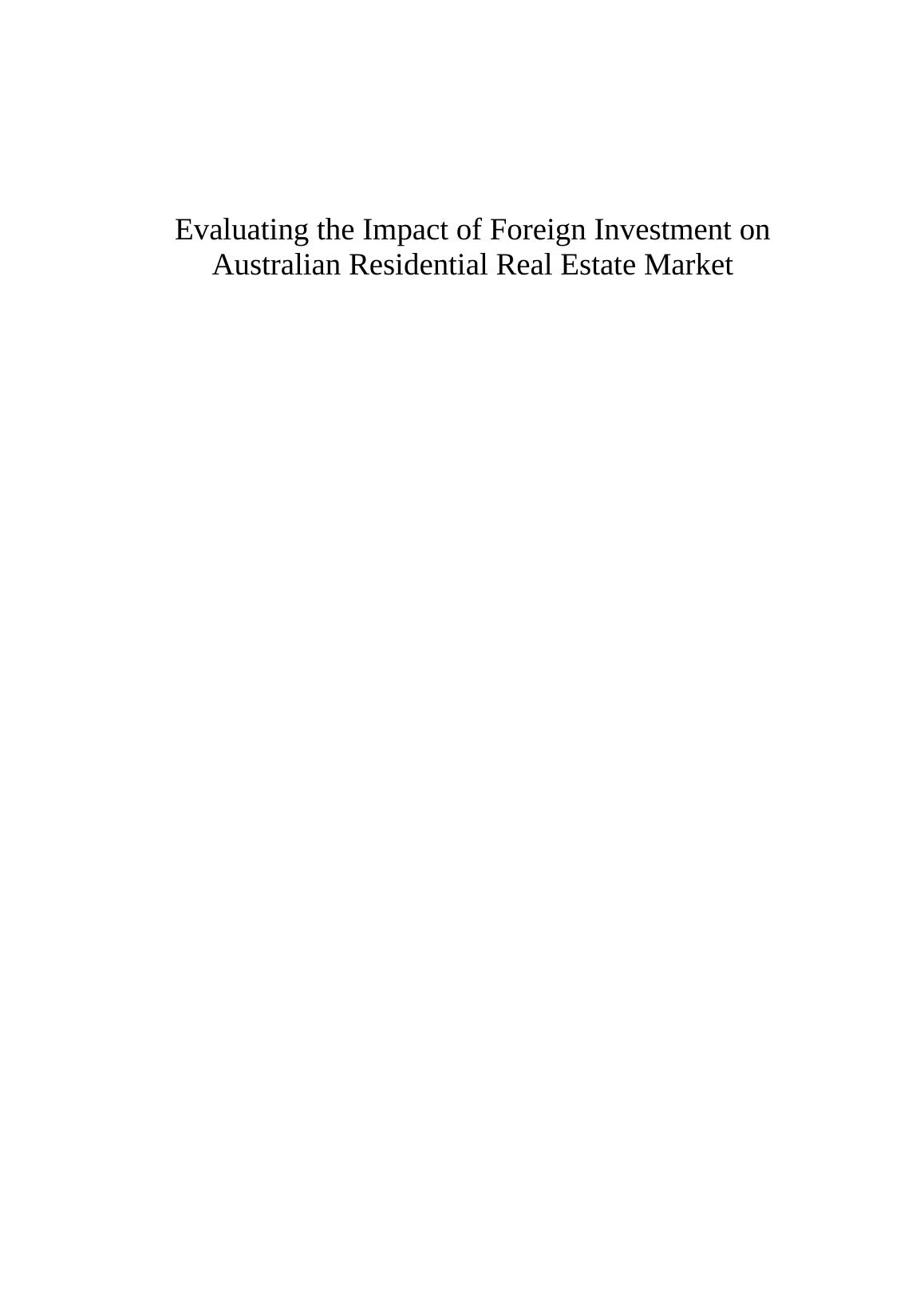
Abstract
This paper that has been prepared has the intention of creating an understanding of the
impact foreign investment has on the residential housing sector in Australia. In accordance
to this, the background of the paper has been provided in order to provide a brief idea
about foreign investment accordingly an idea about the residential housing sector in
Australia. The research question and the objectives of the paper have tried to point out the
areas with respect to which the research would move forward. The literature has provided
an idea about foreign investment and how it has impacted Australia in the housing sector
earlier. The elements that significantly have an impact has been addressed. The
methodology in the same way has provided an idea on the data that has been collected and
the analysis process that has been used. The outcome of the paper has been able to address
the fact that foreign investments do impact the housing sector and the paper would
extensively explain the degree to which the impact takes place.
1
This paper that has been prepared has the intention of creating an understanding of the
impact foreign investment has on the residential housing sector in Australia. In accordance
to this, the background of the paper has been provided in order to provide a brief idea
about foreign investment accordingly an idea about the residential housing sector in
Australia. The research question and the objectives of the paper have tried to point out the
areas with respect to which the research would move forward. The literature has provided
an idea about foreign investment and how it has impacted Australia in the housing sector
earlier. The elements that significantly have an impact has been addressed. The
methodology in the same way has provided an idea on the data that has been collected and
the analysis process that has been used. The outcome of the paper has been able to address
the fact that foreign investments do impact the housing sector and the paper would
extensively explain the degree to which the impact takes place.
1
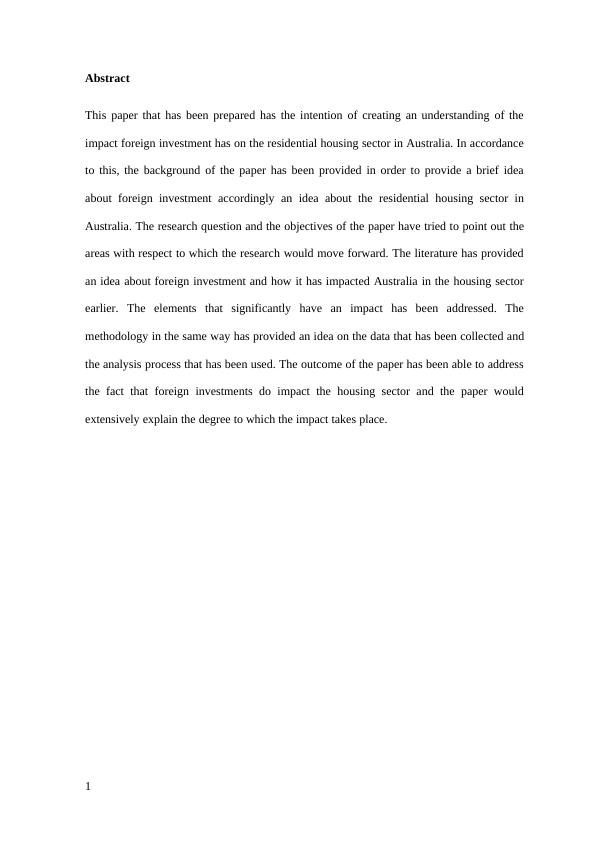
Table of Contents
Chapter 1: Introduction..........................................................................................................4
1.1 Background...................................................................................................................5
1.2 Problem statement........................................................................................................7
1.3 Aims and Objectives.....................................................................................................7
1.4 Research Questions......................................................................................................7
Chapter 2: Literature Review.................................................................................................8
2.1 Foreign Investment in Australia..............................................................................9
2.2 Development of Foreign Investment Trends..............................................................12
2.3 Residential Tourism....................................................................................................13
2.4 Education and Migration............................................................................................14
2.5 Established Factors.....................................................................................................15
2.6 Resolution to Traditional problems............................................................................16
2.7 Factors responsible for the growth of Residential area..............................................17
2.8 Problem Statement......................................................................................................17
2.9 Summary.....................................................................................................................18
Chapter 3: Research Methodology.......................................................................................19
3.1 Introduction................................................................................................................19
3.2 Choice of Methodology..............................................................................................19
3.3 Research Philosophy..................................................................................................20
3.4 Research Approach.....................................................................................................20
3.5 Research Design.........................................................................................................20
2
Chapter 1: Introduction..........................................................................................................4
1.1 Background...................................................................................................................5
1.2 Problem statement........................................................................................................7
1.3 Aims and Objectives.....................................................................................................7
1.4 Research Questions......................................................................................................7
Chapter 2: Literature Review.................................................................................................8
2.1 Foreign Investment in Australia..............................................................................9
2.2 Development of Foreign Investment Trends..............................................................12
2.3 Residential Tourism....................................................................................................13
2.4 Education and Migration............................................................................................14
2.5 Established Factors.....................................................................................................15
2.6 Resolution to Traditional problems............................................................................16
2.7 Factors responsible for the growth of Residential area..............................................17
2.8 Problem Statement......................................................................................................17
2.9 Summary.....................................................................................................................18
Chapter 3: Research Methodology.......................................................................................19
3.1 Introduction................................................................................................................19
3.2 Choice of Methodology..............................................................................................19
3.3 Research Philosophy..................................................................................................20
3.4 Research Approach.....................................................................................................20
3.5 Research Design.........................................................................................................20
2

3.6 Data Collection Process..............................................................................................21
3.7 Research Methods and data sources...........................................................................21
3.8 Ethics..........................................................................................................................22
3.9 Summary.....................................................................................................................22
Chapter 4: Data Analysis and Discussion............................................................................23
4.1 Introduction................................................................................................................23
4.2 Housing Occupancy and Costs...................................................................................23
4.3 Migration....................................................................................................................25
4.4 Estimated Resident Population...................................................................................28
4.5 Discussion...................................................................................................................30
Chapter 5: Conclusion, Limitation and Future Work...........................................................31
5.1 Conclusion..................................................................................................................31
5.2 Recommendations......................................................................................................32
5.3 Limitations..................................................................................................................33
5.4 Future Research..........................................................................................................33
Reference List......................................................................................................................34
Bibliography.........................................................................................................................41
3
3.7 Research Methods and data sources...........................................................................21
3.8 Ethics..........................................................................................................................22
3.9 Summary.....................................................................................................................22
Chapter 4: Data Analysis and Discussion............................................................................23
4.1 Introduction................................................................................................................23
4.2 Housing Occupancy and Costs...................................................................................23
4.3 Migration....................................................................................................................25
4.4 Estimated Resident Population...................................................................................28
4.5 Discussion...................................................................................................................30
Chapter 5: Conclusion, Limitation and Future Work...........................................................31
5.1 Conclusion..................................................................................................................31
5.2 Recommendations......................................................................................................32
5.3 Limitations..................................................................................................................33
5.4 Future Research..........................................................................................................33
Reference List......................................................................................................................34
Bibliography.........................................................................................................................41
3

Chapter 1: Introduction
The housing sector is currently considered to an essential element in evaluating the
welfare of the economy of a country. Traditionally, the assessment of the housing market
has been easy as the dependence has been mainly on the balance of the national demand
and supply and it was examined specifically with the segregation of the other markets. In
the current time period, this process is of no use because of the fact that the global
characteristic of the market (Ferrero 2015). This explains that the previous process of
examining the market is of no use as the assessment of the market does not require the help
of the domestic factors and it is even seen that the domestic factors are even associated
with complexities and various issues. Therefore, in order to have an idea about the market,
it is essential to consider as a complicated economic environment that is effected by
several factors which are international and domestic in nature.
There exists an extensive relationship between the housing sector and the other
sectors like the financial and the labour sector, which makes it hard to assess in the
segregation. The interdependence was very much highlighted after the financial crisis took
place in the year 2008, when there had been a downfall of the housing market in several
countries. The downfall in the housing sector had significant amount of impact on the
overall economy of the countries and therefore this incident acts as an example in order to
address the significance of the housing markets (Jordà, Schularick and Taylor 2015). Their
authority to have an effect on the economies all over the globe should be taken into
consideration.
In the recent time period, there has been an observation that there has been a shift
within the capacity within which the customers participate within the housing market. In
the past intestates in the housing market was looked upon to be a long term asset. In the
4
The housing sector is currently considered to an essential element in evaluating the
welfare of the economy of a country. Traditionally, the assessment of the housing market
has been easy as the dependence has been mainly on the balance of the national demand
and supply and it was examined specifically with the segregation of the other markets. In
the current time period, this process is of no use because of the fact that the global
characteristic of the market (Ferrero 2015). This explains that the previous process of
examining the market is of no use as the assessment of the market does not require the help
of the domestic factors and it is even seen that the domestic factors are even associated
with complexities and various issues. Therefore, in order to have an idea about the market,
it is essential to consider as a complicated economic environment that is effected by
several factors which are international and domestic in nature.
There exists an extensive relationship between the housing sector and the other
sectors like the financial and the labour sector, which makes it hard to assess in the
segregation. The interdependence was very much highlighted after the financial crisis took
place in the year 2008, when there had been a downfall of the housing market in several
countries. The downfall in the housing sector had significant amount of impact on the
overall economy of the countries and therefore this incident acts as an example in order to
address the significance of the housing markets (Jordà, Schularick and Taylor 2015). Their
authority to have an effect on the economies all over the globe should be taken into
consideration.
In the recent time period, there has been an observation that there has been a shift
within the capacity within which the customers participate within the housing market. In
the past intestates in the housing market was looked upon to be a long term asset. In the
4
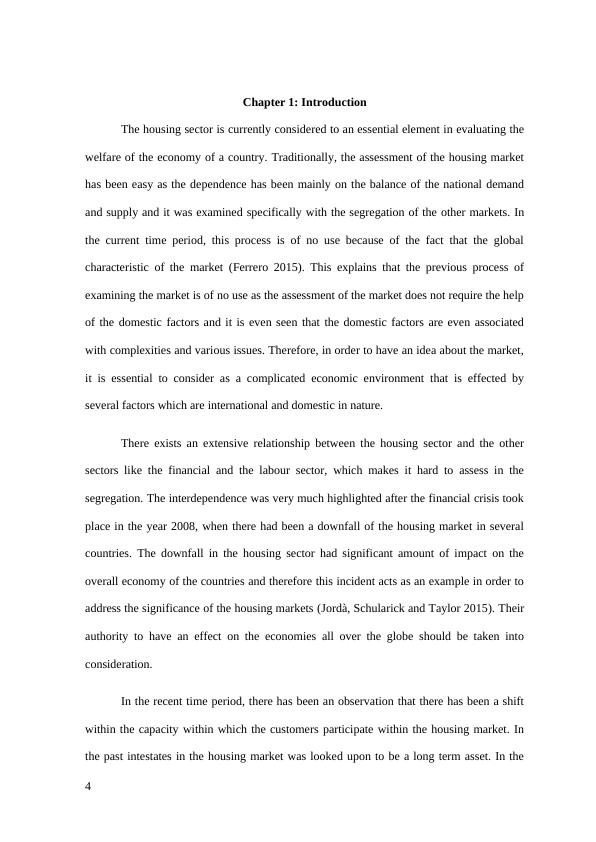
current time period, the purchase of the real estate is regarded as an investment and
therefore the national and the foreign investors have started showing significant amount of
interests as there has been a rise in the demand for house in distinct areas. The countries
that have developed economies, high standard of living and stabilised governments are
mostly targeted by the investors (Yunus 2015). The housing market gaining the features of
the financial markets has motivated the investors to undertake investments in this market
and the result has been observed in countries like Australia.
Due to the growth of foreign residents in Australia the residential housing market
has seen an increase in new residents participating in purchasing property. The purpose of
this article is to analyse the impact of foreign investment and affordability in the housing
market. The demand for residential housing is increasing with the expanding purchases
from foreign investors. The price of dwellings is also increasing due to the high demand.
Legislative laws are developed in Australia to promote local construction for the
development of dwelling houses (KPMG Economics, 2017). Residential projects are
purchased by foreign investors or domestic buyers. The GDP rate of Australia is increased
due to the foreign investment from various sources in the residential housing market which
contributes to better living conditions.
1.1 Background
Morano and Tajani (2017) explained that investors from China and the Chinese
migrants who have newly arrived undertakes an investment of around AUD 44 billion in
the residential real estate market of Australia within the year of 2014 to 2021. Shaw and
Hagemans (2015) addressed that most of the investments in the residential housing market
in Australia has been undertaken in Melbourne and Sydney. It is seen that approximately
14% in Melbourne and 18% in Sydney has been purchased by the foreigners. Therefore,
5
therefore the national and the foreign investors have started showing significant amount of
interests as there has been a rise in the demand for house in distinct areas. The countries
that have developed economies, high standard of living and stabilised governments are
mostly targeted by the investors (Yunus 2015). The housing market gaining the features of
the financial markets has motivated the investors to undertake investments in this market
and the result has been observed in countries like Australia.
Due to the growth of foreign residents in Australia the residential housing market
has seen an increase in new residents participating in purchasing property. The purpose of
this article is to analyse the impact of foreign investment and affordability in the housing
market. The demand for residential housing is increasing with the expanding purchases
from foreign investors. The price of dwellings is also increasing due to the high demand.
Legislative laws are developed in Australia to promote local construction for the
development of dwelling houses (KPMG Economics, 2017). Residential projects are
purchased by foreign investors or domestic buyers. The GDP rate of Australia is increased
due to the foreign investment from various sources in the residential housing market which
contributes to better living conditions.
1.1 Background
Morano and Tajani (2017) explained that investors from China and the Chinese
migrants who have newly arrived undertakes an investment of around AUD 44 billion in
the residential real estate market of Australia within the year of 2014 to 2021. Shaw and
Hagemans (2015) addressed that most of the investments in the residential housing market
in Australia has been undertaken in Melbourne and Sydney. It is seen that approximately
14% in Melbourne and 18% in Sydney has been purchased by the foreigners. Therefore,
5
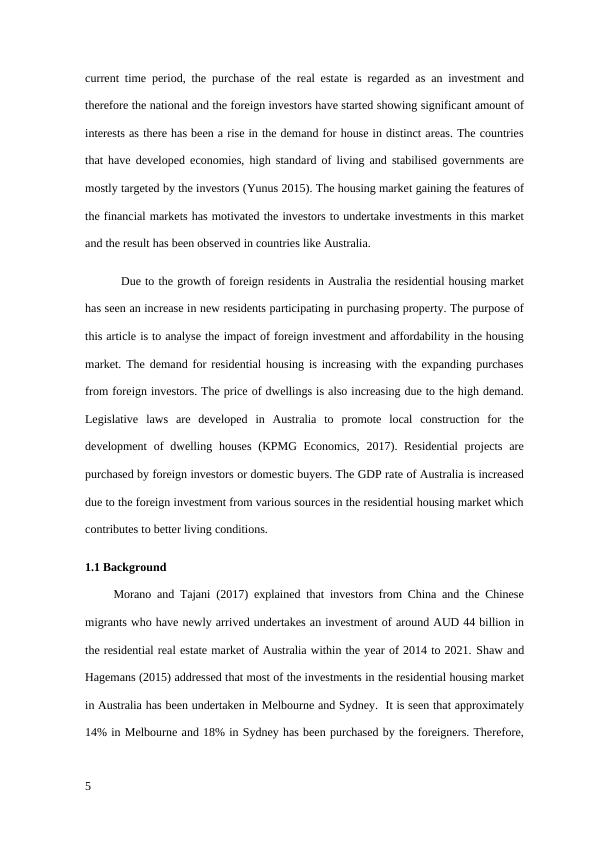
this addressed that the foreign investors have kept a pressure on the housing prices within
the capital cities.
The housing prices in both the cities have been reasonably high and in the current
time period the prices have gone so up that it has become difficult for the local purchasers
to purchase a house. The rise in the level of interest from the Chinese investors has led to
the rise in the housing prices and the banks who are operational in the country have
indicated that this feature would lead to inflation in the prices of the property. The rise in
demand in the housing sector in Australia has mainly been due to the rise in income level
of the residents and therefore they have shown key interest in purchasing properties with
the help of which they can undertake investments and accordingly can maintain assets in
their financial portfolio as well (Cesa‐Bianchi, Cespedes and Rebucci 2015). These have
been the factors that have motivated the increased in foreign investments in the Australian
residential sector and accordingly have developed the housing market in the country.
The increasing demand of residential dwellings has resulted into the rise of price
which is around 7.25 % every year. An analysis of residential prices in the past decade of
capital cities of Australia found an average increase of 2.5% (Kohler and Van, 2015).The
performance of Australian investors is improving with the association and consideration of
immigrants in the Australian policy of real estate (Masron and Kepili, 2016). Foreign
residents are also participating in the process of purchasing the houses (Sharpnel, 2016).
Recent studies assist in providing information concluding that 10 to 20% of purchases of
dwellings is done by foreign investors. Population growth also increases the demand of
residential houses for both locals and immigrants.
6
the capital cities.
The housing prices in both the cities have been reasonably high and in the current
time period the prices have gone so up that it has become difficult for the local purchasers
to purchase a house. The rise in the level of interest from the Chinese investors has led to
the rise in the housing prices and the banks who are operational in the country have
indicated that this feature would lead to inflation in the prices of the property. The rise in
demand in the housing sector in Australia has mainly been due to the rise in income level
of the residents and therefore they have shown key interest in purchasing properties with
the help of which they can undertake investments and accordingly can maintain assets in
their financial portfolio as well (Cesa‐Bianchi, Cespedes and Rebucci 2015). These have
been the factors that have motivated the increased in foreign investments in the Australian
residential sector and accordingly have developed the housing market in the country.
The increasing demand of residential dwellings has resulted into the rise of price
which is around 7.25 % every year. An analysis of residential prices in the past decade of
capital cities of Australia found an average increase of 2.5% (Kohler and Van, 2015).The
performance of Australian investors is improving with the association and consideration of
immigrants in the Australian policy of real estate (Masron and Kepili, 2016). Foreign
residents are also participating in the process of purchasing the houses (Sharpnel, 2016).
Recent studies assist in providing information concluding that 10 to 20% of purchases of
dwellings is done by foreign investors. Population growth also increases the demand of
residential houses for both locals and immigrants.
6
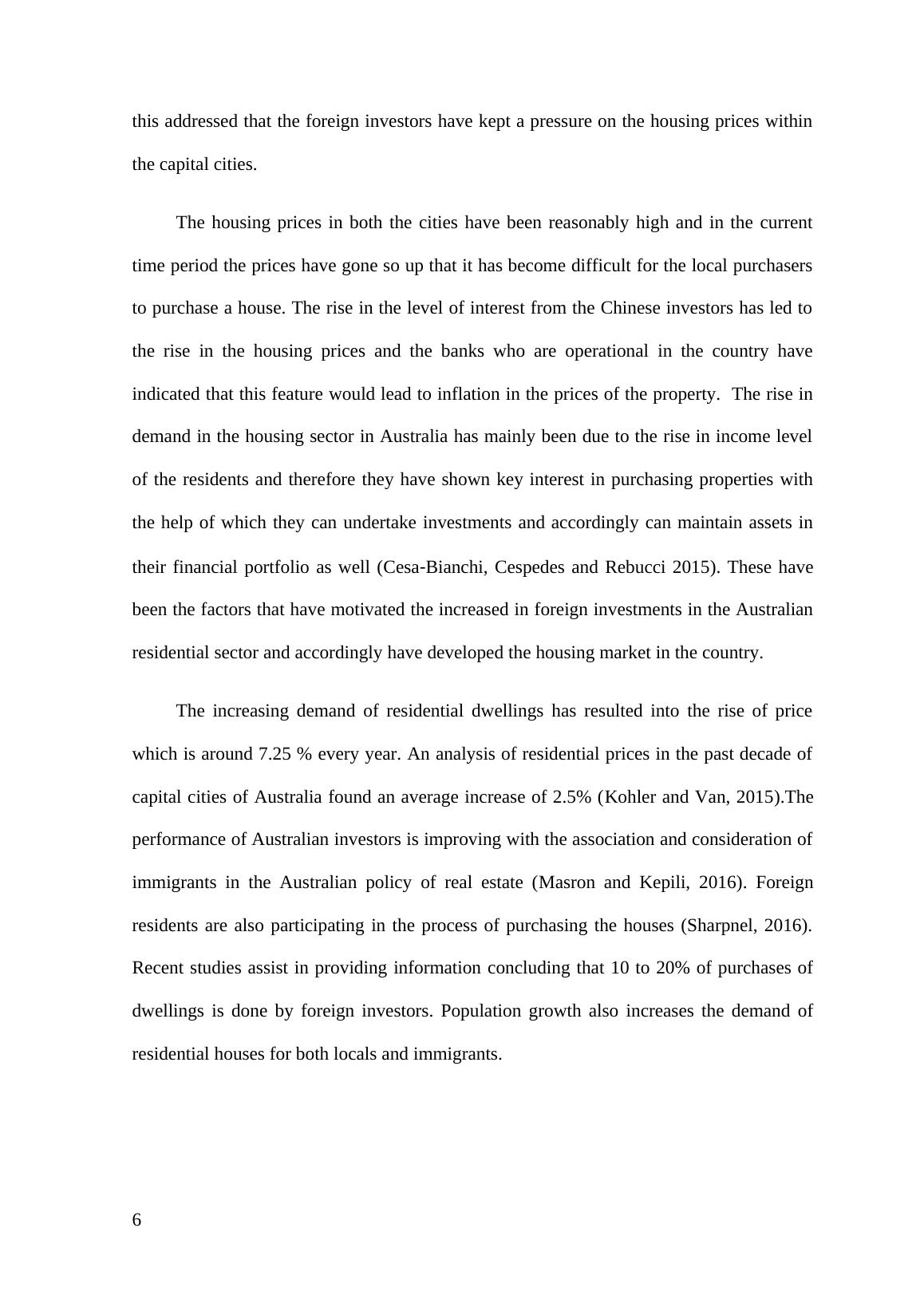
Figure 1: Average National house pricing growth (Kohler and Van, 2015)
1.2 Problem statement
The major problem that exists with housing investment is the increase in price of
dwellings due to the escalating demand from foreign residents. This has impacted on the
affordability of housing especially in the 1st home buyer market..
1.3 Aims and Objectives
The aim of the research program is to analyse the impact of foreign investment and
housing affordability in the residential real estate market. The research helps focus on the
factors which are responsible for the increasing demand of residential houses.
1.4 Research Questions
The research questions which are designed for undertaking the research on impact
of foreign investment are given below:
Q1. What is the impact of foreign investment on the growth of residential real estate?
Q2. Why are foreign investors interested in investing in residential dwellings?
Q3. Why there is a significant increase in the price of the dwellings?
7
1.2 Problem statement
The major problem that exists with housing investment is the increase in price of
dwellings due to the escalating demand from foreign residents. This has impacted on the
affordability of housing especially in the 1st home buyer market..
1.3 Aims and Objectives
The aim of the research program is to analyse the impact of foreign investment and
housing affordability in the residential real estate market. The research helps focus on the
factors which are responsible for the increasing demand of residential houses.
1.4 Research Questions
The research questions which are designed for undertaking the research on impact
of foreign investment are given below:
Q1. What is the impact of foreign investment on the growth of residential real estate?
Q2. Why are foreign investors interested in investing in residential dwellings?
Q3. Why there is a significant increase in the price of the dwellings?
7
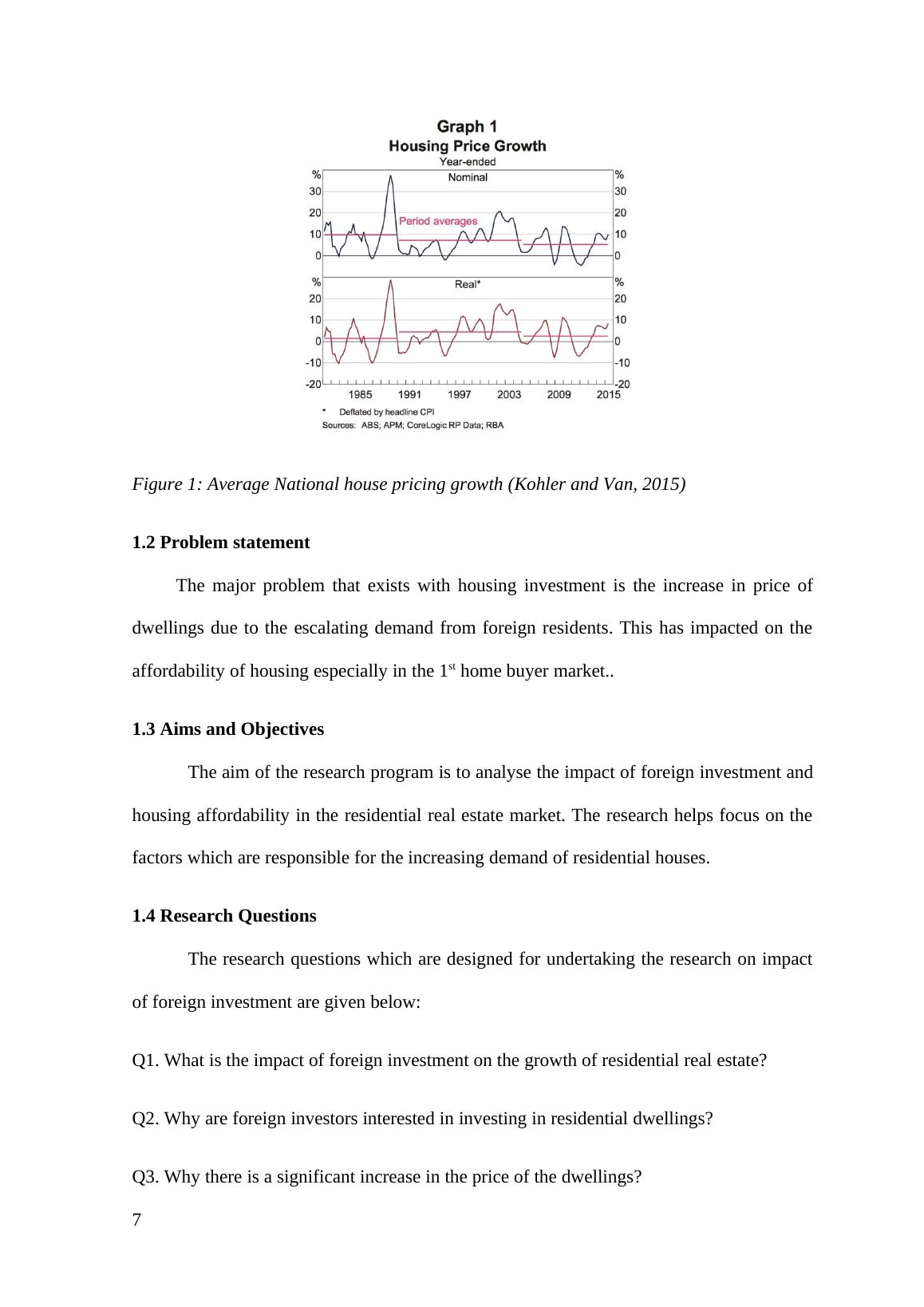
End of preview
Want to access all the pages? Upload your documents or become a member.
Related Documents
DETERMINANTS OF FDI IN TRANSITION ECONOMIES IN SEE COUNTRIES ANDlg...
|81
|18986
|2
Financial Transition - Doclg...
|82
|20929
|35
Foreign investment impact on Australian residential real estate market and housing affordabilitylg...
|9
|2726
|327
BUSINESS DEVELOPMENT PLAN CHAPTER 1: INTRODUCTION1 1.1 Background of the research 1 1.2 Business opportunity 2 1.3 Business Model 4 1.4 Structure of the work 5 CHAPTER 2: THE BUSINESS OPPORTUNITY 6 CHlg...
|42
|15546
|470
IMPACT OF SERVICE QUALITY ON CUSTOMER LOYALTY IN BAKING INDUSTRYlg...
|65
|14260
|19
The Effect of Environmental Management on the Business Performance of the Manufacturing Firmslg...
|83
|13818
|239
